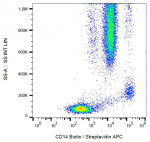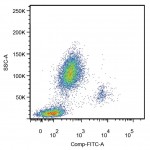Search Result - Primary Antibodies
There are 1228 results for "Glycoprotein"
- anti-CD14 antibody [MEM-15] (Biotin)
- Cat. No: ARG62724 (Mouse mAb)
- Reactivity: Hu, NHuPrm
- Application: FACS
- Specificity: The clone MEM-15 reacts with CD14, a 53-55 kDa GPI (glycosylphosphatidylinositol)-linked membrane glycoprotein expressed on monocytes, macrophages and weakly on granulocytes; also expressed by most tissue macrophages.
MEM-15 also reacts with soluble forms of CD14 found in serum and in the urine of some nephrotic patients.
HLDA III; WS Code M 252
HLDA IV; WS Code M 113
HLDA IV; WS Code NL 90
HLDA IV; WS Code T 53
HLDA V; WS Code M MA086
HLDA VI; WS Code M MA94 - Conjugation: Biotin
- anti-CD14 antibody [MEM-15]
- Cat. No: ARG62726 (Mouse mAb)
- Reactivity: Hu, NHuPrm
- Application: FACS, IP
- Specificity: The clone MEM-15 reacts with CD14, a 53-55 kDa GPI (glycosylphosphatidylinositol)-linked membrane glycoprotein expressed on monocytes, macrophages and weakly on granulocytes; also expressed by most tissue macrophages.
MEM-15 also reacts with soluble forms of CD14 found in serum and in the urine of some nephrotic patients.
HLDA III; WS Code M 252
HLDA IV; WS Code M 113
HLDA IV; WS Code NL 90
HLDA IV; WS Code T 53
HLDA V; WS Code M MA086
HLDA VI; WS Code M MA94 - Conjugation: Un-conjugated
- anti-CD14 antibody [MEM-18] (FITC)
- Cat. No: ARG62728 (Mouse mAb)
- Reactivity: Hu, NHuPrm
- Application: FACS
- Specificity: The clone MEM-18 reacts with CD14, a 53-55 kDa GPI (glycosylphosphatidylinositol)-linked membrane glycoprotein expressed on monocytes, macrophages and weakly on granulocytes; also expressed by most tissue macrophages. In human, the epitope recognized by MEM-18 is located between amino acids 57-64.
HLDA III; WS Code M 253
HLDA IV; WS Code M 314
HLDA V; WS Code M MA087
HLDA VI; WS Code M MA95 - Conjugation: FITC
- anti-CD14 antibody [MEM-15] (FITC)
- Cat. No: ARG62729 (Mouse mAb)
- Reactivity: Hu, NHuPrm
- Application: FACS
- Specificity: The clone MEM-15 reacts with CD14, a 53-55 kDa GPI (glycosylphosphatidylinositol)-linked membrane glycoprotein expressed on monocytes, macrophages and weakly on granulocytes; also expressed by most tissue macrophages.
MEM-15 also reacts with soluble forms of CD14 found in serum and in the urine of some nephrotic patients.
HLDA III; WS Code M 252
HLDA IV; WS Code M 113
HLDA IV; WS Code NL 90
HLDA IV; WS Code T 53
HLDA V; WS Code M MA086
HLDA VI; WS Code M MA94 - Conjugation: FITC
- anti-CD59 antibody [MEM-129] (azide free)
- Cat. No: ARG62898 (Mouse mAb)
- Reactivity: Hu, Pig
- Application: FACS, FuncSt
- Specificity: The clone MEM-129 reacts with CD59 (Protectin), a 18-20 kDa glycosylphosphatidylinositol (GPI)-anchored glycoprotein expressed on all hematopoietic cells; it is widely present on cells in all tissues.
- Conjugation: Un-conjugated
- anti-CD90.2 / Thy 1.2 antibody [F7D5]
- Cat. No: ARG22885 (Mouse mAb)
- Reactivity: Ms
- Application: FACS
- Specificity: The clone F7D5 recognizes the mouse Thy1.2 alloantigen, also known as CD90.2, which is expressed by thymocytes and peripheral T lymphocytes. Clone F7D5 reacts with Thy1.2 mice such as CBA and BALB/C, but not with Thy1.1 mice eg. AKR and FUB.
- Conjugation: Un-conjugated
- anti-CD200 antibody [OX-90] (Biotin)
- Cat. No: ARG22974 (Rat mAb)
- Reactivity: Ms
- Application: FACS
- Conjugation: Biotin
- anti-CD200 antibody [OX-90] (FITC)
- Cat. No: ARG22975 (Rat mAb)
- Reactivity: Ms
- Application: FACS
- Conjugation: FITC
- anti-CD200 antibody [OX-104] (FITC)
- Cat. No: ARG22843 (Mouse mAb)
- Reactivity: Hu
- Application: FACS
- Conjugation: FITC
- anti-CD200 antibody [OX-104] (PE)
- Cat. No: ARG22844 (Mouse mAb)
- Reactivity: Hu
- Application: FACS
- Conjugation: PE



